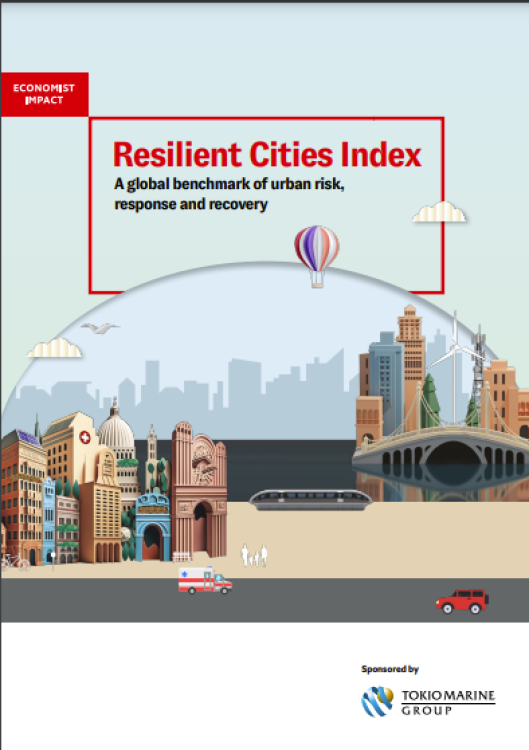Resilient cities study rates New York top and London third

New York has been named as the global city with the most ability to adapt to the risks and uncertainties of the new century most effectively. This was the conclusion of a new report, The Resilient Cities Index, published by The Economist and sponsored by Tokio Marine.
New York was top, followed by Los Angeles, before the highest-rated European city was London, then came Paris and Amsterdam. The highest-rated Asian city was Singapore, followed by Tokyo. Melbourne was the highest-placed Australian settlement.
There were six main findings to the report, which was launched at a briefing held at Tokio Marine’s London office.
“The Resilient Cities Index is intended to identify gaps and challenges our cities face, giving insights into the opportunities and the way forward," said Brad Irick, CEO, Tokio Marine Kiln and executive officer of Tokio Marine.
"The research is intended to empower policymakers, city planners and communities to formulate targeted strategies that help ensure that cities not only survive, but thrive amid challenges. There are lessons to be learned for London, and it’s important insurance ecosystem,” he added.
Jonathan Birdwell, global head of policy and insights, The Economist, said: “One thing the index highlights is that stark fact that the cities in emerging markets facing the biggest risks, don’t have the adequate policies and finances to be able to meet those risks.
He emphasised that 1.8 billion people live in flood risk areas and that Asia is particularly vulnerable, with its cities’ temperatures warming faster than the global average.
“Last year, Asia experienced 81 climate and water related events, including droughts and floods, that, unfortunately led to the loss of life of 5,000 people, affected 50 million people, and led to over $36bn in damage,” he said.
Rapid urbanisation is making this threat more urgent, the study emphasised.
“The context for this work is global uncertainty is really at an all-time high. The impact is even greater in densely-populated areas…We see increasing urbanisation…two thirds of the world’s population will be living in cities and 2050,” Birdwell added.
Most cities, the authors decreed, performed well in the critical infrastructure pillar of the index but had weak points that need strategic focus.
The authors wrote: “The cities with the highest scores were Dubai, Shanghai, New York and Singapore. These capital-rich market locations have greater opportunities to develop new infrastructure, compared with European cities constrained by decades- or centuries-old systems. Within this pillar, digital infrastructure and transportation were a drag on cities’ resilience.”
It was also posited that most cities demonstrated poorer performance in the socio-institutional pillar, mostly due to income inequality and poor health and well-being metrics. Only nine had a single, comprehensive plan to support vulnerable groups. However, cities were promoting a culture of readiness to act in the event of a disaster. The majority scored highly on this or are working to improve their readiness.
The authors also found that cities adept at using data and technology to create operational efficiencies and share information with citizens were better at dealing with shocks.
Writing in the report, the authors said: “Patchy internet quality, which can impede access to digital services, pulled down the overall resilience score in the critical infrastructure pillar. Digital technologies and advanced data analytics can help to predict risks, optimise existing systems and keep the public informed. Greater digitalisation comes with risks, especially to critical infrastructure, but most cities in the index have built safeguards against this.”
Meanwhile, it was also found that most emerging economy cities lack adequate regulatory frameworks, strategies and incentives for future- proofing infrastructure.
Efforts to achieve environmental resilience, said the report are led by innovative solutions, including a variety of nature-based solutions to adapt to flooding and heat stress, from planting rooftop vegetation and mangrove forests (green infrastructure) to rehabilitating wetlands (blue infrastructure). Cities are also decarbonising by adopting renewable energy and negative emission technologies, such as carbon capture, storage and removal. However, the scalability of these technologies is likely to be challenging for resource-constrained emerging market cities.
Overall, the authors said that cities had the lowest average scores in the economic pillar, dragging down some cities that performed well in other areas.
They wrote: “The low penetration of financial safety nets hinders safeguards against threats and undermines a city’s ability to recover from shocks. Another aspect of economic resilience is a city’s ability to incubate innovation, which can foster solutions to a range of problems, from congestion to water stress. Unfortunately, most cities scored poorly on the indicator for start-up ecosystems.”
